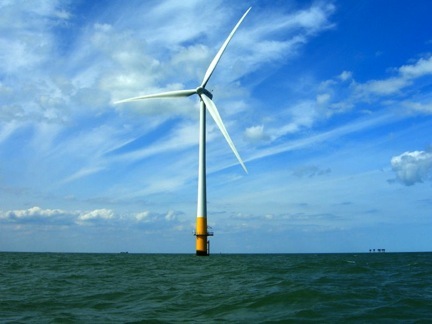
Photo: Phil Hollman.
By Courtney Bourgoin
A new Great Lakes wind tracker is filling the gaps of its predecessors.
The Technical University of Denmark teamed with Cornell University to create the Great Lake’s first full observational wind atlas – a way of collecting data on wind patterns for electricity generation.
What makes this atlas different than past tracking systems is its ability to collect longtime, more consistent data over an area, according to a Cornell news release.
This sort of research is not a new concept for the Great Lakes region, said John Sarver, president of Great Lakes Renewable Energy Association (GLREA), a statewide nonprofit organization. The National Renewable Energy Laboratory and Grand Valley State University have conducted similar studies in the past, Sarver said.
However, spatial variations like ice coverage in winter months have left gaps in previous offshore wind atlas research, according to Paula Doubrawa, the lead Cornell researcher conducting the atlas research announced on Sept. 8.
The new atlas shows the potential the lakes hold for providing energy. It tracks wind direction and patterns to help select locations of offshore wind farms, according to Cornell. These offshore wind farms use turbines to exploit energy that’s created from strong winds over large bodies of water.
The data comes from weather stations, buoys, a NASA wind satellite and other satellites, Cornell’s Blaine Friedlander said in the release. The multiple sources offer more accurate data for wind tracking.
“The techniques that we have employed optimize the strength of these measurement types,” Doubrawa said.
In addition, this atlas creates more centralized information regarding wind power on the lakes, which Friedlander called historically “disjointed.”
Sarver promotes such research, where methodology and data improves with increased trials. The studies are a tool for Sarver’s non-profit group, which can connect those interested in offshore energy production to researchers who collect such data, he said.
Still, Sarver notes the minimal likelihood of the atlas resulting in any investments and tangible steps to turbines in the lakes.
It’s just not at its peak economical point yet, he said.
“If you’re talking about a private energy provider or a utility company, they’re probably going to look to onshore wind production,” Sarver said. “It’s much cheaper to invest in an onshore wind farm.”
But advancing and improving these atlases will make renewable energy more economical, he said. Because on-the-water wind currents provide better consistency and direction, Sarver said that offshore production could eventually become a valuable resource in developing a Great Lakes region energy market.
A study conducted in January by the Lake Erie Energy Development Corp. showed that Lake Erie could produce 50 gigawatts of the United States’ estimated potential 4,223 gigawatts produced from only offshore sources.
The atlas research was funded by the U.S. Department of Energy, the National Science Foundation and the National Renewable Energy Laboratory. Information about it can be found in the journal Remote Sensing of Environment in an article titled “Satellite winds as a tool for offshore wind resource assessment: The Great Lakes Wind Atlas” (October 2015).